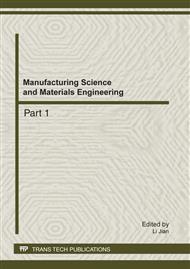[1]
Van Nee R J, Prasard R. OFDM For Wireless Multimedia Communications. Artech House, Boston, (1999).
Google Scholar
[2]
Xiaodong Li and Leonard J. Cimini, Effects of clipping and Filtering on the Performance of OFDM,. IEEE, 1997, pp.1634-1638.
Google Scholar
[3]
R.W. Bauml, et al. , Reducing the Peak-to-average Power Ratio of Multicarrier Modulation by Selected Mapping,. Electronics Letters, 1996, 32(22), p.2056-(2057).
DOI: 10.1049/el:19961384
Google Scholar
[4]
Stefan H. Muller, Johannes B. Huber, A Novel Peak Power Reduction Scheme for OFDM". PIMRC, 97, Sept, 1997, pp.1090-1094.
Google Scholar
[5]
A.D.S. Jayalath, C. Tellambura and H. Wu, Reduced complexity PTS and new phase sequences for SLM to reduce PAP of an OFDM signa,. IEEE VTC2000, p.1914-(1917).
DOI: 10.1109/vetecs.2000.851605
Google Scholar
[6]
Stefan H. Muller, Johannes B. Huber, A Comparison of peak power reduction schemes for OFDM,. IEEE Global Telecommunication Conference, November, (1997).
Google Scholar
[7]
A.D.S. Jayalath, et al. , Adaptive PTS Approach for Reduction Peak-to-average Power Ratio of OFDM Signa,. Electronics Letters, 2000, 36(4), pp.1226-1227.
DOI: 10.1049/el:20000881
Google Scholar
[8]
J. Tellado, Peak to Average Power Reduction for Multicarrier Modulation,. Ph.D. dissertation, Stanford University, (2000).
Google Scholar
[9]
J. A. Davis, J. Jedwab, Peak-to-mean Power Control and Error Correction for OFDM Transmission Using Golay Sequences and Reed-Muller Codes,. Elect. Lett., vol. 33, no. 4, Feb. 1997, pp.267-268.
DOI: 10.1049/el:19970205
Google Scholar
[10]
A.D.S. Jayalath, C. Tellambura and H. Wu, Reduced complexity PTS and new phase sequences for SLM to reduce PAP of an OFDM signa,. IEEE VTC2000, p.1914-(1917).
DOI: 10.1109/vetecs.2000.851605
Google Scholar
[11]
G. T. Zhou, R.J. Baxley, N. Chen, Selected mapping with monomial phase rotations for peak-to-average power ratio reduction in OFDM,. ICCCAS, 2004, vol. 1, 27-29, pp.66-70.
DOI: 10.1109/icccas.2004.1345941
Google Scholar
[12]
Park, M., Heeyong, J., Cho, N., Hong, D, and Kang, C. , PAPR reduction in OFDM transmission using Hadamard transform, IEEE International Conference on Communications, Vol. 1, June (2000).
DOI: 10.1109/icc.2000.853355
Google Scholar
[13]
P. Cheng, Y. Xiao, L. Dan and S. Li, Improved SLM for PAPR Reduction in OFDM system,. Personal, Indoor and Mobile Radio Communications, Sept, 2007, pp.1-5.
DOI: 10.1109/pimrc.2007.4394556
Google Scholar
[14]
J. Wang; J. Luo and Y. Zhang, A New Phase Sequence for SLM in MCCDMA system,. International Conference on Wireless Communications, Networking and Mobile Computing, 2007, pp.938-941.
DOI: 10.1109/wicom.2007.241
Google Scholar
[15]
Kyeongcheol Yang, Seok-II Chang, Peak-to-Average Power Control in OFDM Using Standard Arrays of Linear Block Code,. IEEE Communications, 2003, 7(4), pp.174-176.
DOI: 10.1109/lcomm.2003.811204
Google Scholar
[16]
Lin Chen, Xuelong Hu, A Novel Method of Using Standard Arrays to Reduce the Peak-to-Average Power Ratio,. Radio Communications Technology, 2006, 32(3), pp.62-64.
Google Scholar
[17]
N. VishnuLanth. I, V. K. Chankka and A. Jain, SLM based PAPR reduction of an OFDM signal using new phase sequence, IEEE Electronica Letters, July, (2009).
DOI: 10.1049/el.2009.1902
Google Scholar
[18]
J. A. Davis, J. Jedwab, Peak-to-mean Power Control in OFDM, Golay Complementary Sequences and Reed-Muller Codes,. IEEE Trans. Inform. Theory, vol. 45. Nov, 1999, pp.2397-2417.
DOI: 10.1109/18.796380
Google Scholar
[19]
K. Patterson, Generalized Reed-Muller Codes and Power Control in OFDM Modulatio., IEEE Trans. Info. Theory, vol. 46, no. 1, Jan. 2000, pp.104-120.
DOI: 10.1109/18.817512
Google Scholar
[20]
C. V. Chong and V. Tarokh, A Simple Encodable/Decodable OFDM QPSK Code with Low Peak-to-Mean Envelope Power Ration., IEEE Trans. Info. Theory, vol. 47, no. 7, Nov. 2001, pp.3025-3029.
DOI: 10.1109/18.959282
Google Scholar
[21]
C. Robing and V. Tarokh, A Construction of OFDM 16-QAM sequences having low peak powers., IEEE Trans. Inform. Theory, vol. 47, no. 5, July. 2001, p.2091-(2094).
DOI: 10.1109/18.930949
Google Scholar
[22]
H. Lee and S. Golomb, A New Construction of 64-QAM Golay Complementary Sequences., IEEE Trans. Inform. Theory, vol. 52, no. 4, Apr. 2006, pp.1663-1670.
DOI: 10.1109/tit.2006.871616
Google Scholar
[23]
Lin Chen, Zhenmin Guo, Xuelong Hu, The Research on the PAPR Reduction in OFDM Systems,. Radio Communications Technology, 2003, 29(6), pp.6-7.
Google Scholar
[24]
Lin Chen, Zhenmin Guo, Jizhao Hua, A Method of Using Complementary Golay Sequences to reduce the PAPR,. TV Engineering, No. 258, December, 2003, pp.25-27.
Google Scholar
[25]
H. H. Seung, J. H Lee, An Overview of Peak-to-Average Power Ratio Reduction Techniques for Multicarrier Transmission., IEEE Wireless Communication Letters, April 2005, pp.56-65.
DOI: 10.1109/mwc.2005.1421929
Google Scholar
[26]
Lin Chen, Xuelong Hu, Research on Peak-to-Average Power Ratio Reduction of an OFDM Signal,. IEEE ICSP, 2008, pp.326-329.
DOI: 10.1109/icnnsp.2008.4590366
Google Scholar
[27]
Lin Chen, Xuelong Hu, Peak-to-Average Power Ratio Reduction of an OFDM Signal Using Signal Scrambling,. 2009 2nd International Congress on Image and Signal Processing,2009, pp.4807-4810.
DOI: 10.1109/cisp.2009.5302974
Google Scholar


